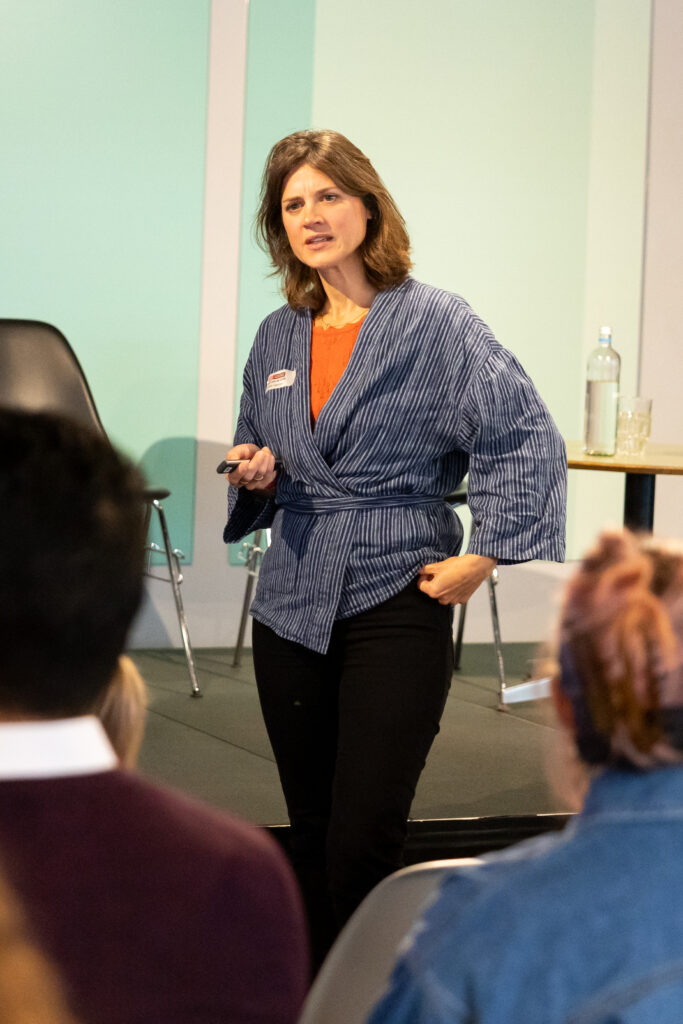
During this interactive workshop, Josje van de Grift and ErnstJan Stroes from Wilde Ganzen, together with storyteller and editor-in-chief Sander Kolsloot of the Dutch cylcling website Hetiskoers.nl, explored what makes stories memorable, motivating, and capable of inspiring collective action. They drew from their work within Connect for Global Change, a new European initiative that promotes equal partnerships, local ownership, flexible funding, and storytelling that strengthens global solidarity. The programme supports small and medium-sized organisations in 11 European countries, with a mission to engage and empower citizens — especially young people and those less aware of global issues — to take shared responsibility for a more just and sustainable world.
Case Study: Studio Kigali & the 2025 Cycling World Championship
To illustrate this in practice, Sander presented the project Studio Kigali, an online storytelling platform connected to the 2025 Cycling World Championship in Rwanda — the first time a major cycling event will be hosted on the African continent. The championship offers a unique opportunity to spotlight diverse African stories beyond the crisis-driven narratives that dominate European media.
Studio Kigali collaborated with Vice Versa Global to work with young Rwandan storytellers, creating articles, vlogs, and podcasts that offer positive, nuanced insights into life in Rwanda and beyond. The aim: to broaden perspectives among cycling fans and counter one-sided depictions of Africa.
A key learning from Sander’s experience was the importance of self-awareness and genuine co-creation. Approaching stories as Dutch outsiders initially led to resistance — reminding the team that impactful storytelling requires listening, sharing ownership, and embracing multiple viewpoints.
“It’s not about the destination — it’s about the journey. I hope that the world will see how important cycling is and what it can do for people.” — Sander Kolsloot
Theory: What Makes a Story That Truly Moves People?
Josje (Wilde Ganzen) introduced a practical storytelling framework built around four essential ingredients. These elements help communicators craft narratives that not only inform audiences but actually shift perspectives and motivate action. Ernst Jan (Wilde Ganzen) filled in the theory with examples of initiatives in Europe working within the Global Connect programme.
It was especially nice to note that it truly lined well with the hope-based messaging of the keynote speaker of the day Thomas Coombes. The workshop emphasised shifting from fear-based to hope-based communication — moving from fear to hope, against to for, problem to solution, threat to opportunity, and victim to human. Hopeful storytelling doesn’t downplay challenges; it reframes them as empowering possibilities rather than sources of paralysis.
1. Emotion – “Move hearts first.”
Facts alone rarely change people’s minds. Emotion is the first doorway to engagement: it captures attention, creates empathy, and makes a story memorable. Examples included Stories of Hope – Tools for Change from Finland, where hopeful personal narratives were used to inspire solidarity rather than overwhelm audiences with global problems. The lesson: start with what people can feel, not what they should know.
2. Identification – “Someone like me.”
For a story to resonate, audiences need to see themselves — or someone they recognise — in it. Identification creates a bridge between the storyteller and the listener, making distant issues feel close and relevant. The example of women food producers in Catalonia illustrated how relatable characters with clear motivations help audiences connect emotionally and intellectually.
3. Gamification – Using playfulness to increase engagement
Playfulness, creativity, and interactivity can lower barriers, spark curiosity, and make complex issues easier to understand. The Belgian initiative Circus4Climate demonstrated how humor, performance, and physical expression can draw people in, especially younger audiences. Gamification encourages participation rather than passive consumption.
4. Personal efficacy – “I can make a difference.”
Even the most compelling story falls flat if it leaves people feeling powerless. Effective storytelling shows audiences the role they can play and offers a pathway to action. The Polish example Time for Change highlighted how stories can empower individuals by making solutions tangible and achievable. When people feel capable of contributing, they are far more likely to act.
Beyond Linear Communication: Stories Aren’t Straight Lines
Wilde Ganzen emphasised that traditional communication theory — the idea that if you give people the right information, they will update their knowledge, change their attitude, and adjust their behaviour — is outdated. Human behaviour is much more complex. Drawing on behavioural science, they used the metaphor from The Elephant, The Rider, and The Path:
- The Elephant represents our emotional, intuitive side.
- The Rider represents rational thinking and logic.
- The Path represents the environment and social context.
For behaviour change to happen, all three must align. A powerful story speaks to the elephant first (emotion), gives the rider reasons to follow (understanding), and shows a clear path forward (actionable steps).
Closing Discussion
The workshop concluded with conversations on how participants could apply these principles to their own projects and communications.

